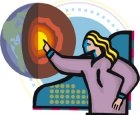
Worksheets and No Prep Teaching Resources
Reading Comprehension Worksheets
Earth Science

Earth Science
 Worksheets and No Prep Teaching Resources Reading Comprehension Worksheets Earth Science |
 Earth Science |
| edHelper's suggested reading level: | grades 6 to 7 | |
| Flesch-Kincaid grade level: | 6.09 |
| Print The Planet Facts! Part 2 (font options, pick words for additional puzzles, and more) |
| Quickly print reading comprehension |
| Print a proofreading activity |
|
The Planet Facts! Part 2
By Trista L. Pollard |

|
| C-Zone | S-Zone | What are they like? |
| Crust/Mantle | Lithosphere | Solid and very rigid rock; about 15 to 300 kilometers thick. |
| Mantle | Asthenosphere | Hotter and softer rock that flows like lava. It is about 200 kilometers thick. |
| Mantle | Mesosphere | The middle layer, which is solid rock. It is below the asthenosphere. |
| Core | Inner Core | Found about 2,900 kilometers below the Earth's surface. It is about 2,300 kilometers thick. |
| Core | Outer Core | The solid, dense metal ball at the center of the Earth. Made of nickel and iron. |
 |
Create Weekly Reading Books
Prepare for an entire week at once! |
| Leave your feedback on The Planet Facts! Part 2 (use this link if you found an error in the story) |
 |
Earth Science
|